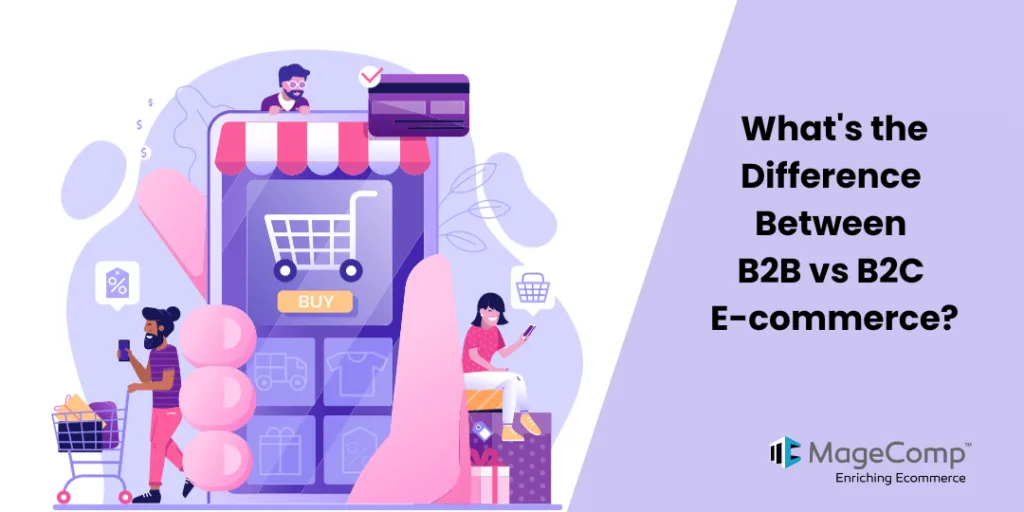E-commerce has become an integral part of the global business landscape, transforming the way companies buy and sell goods and services. Two key models dominate this space: Business-to-Business (B2B) and Business-to-Consumer (B2C) e-commerce. While they share the same digital platform, their strategies, target audiences, and operational dynamics differ significantly.
Understanding the distinctions between B2B and B2C e-commerce is crucial for businesses aiming to thrive in the online marketplace. In this blog post, we will delve into the key differentiators that set B2B and B2C e-commerce apart. But first, let’s get an overview of B2B and B2C e-commerce.
What is B2B E-commerce?
B2B e-commerce is an abbreviated form of Business-to-business e-commerce. It refers to the online exchange of goods, services, and information between businesses. In a B2B e-commerce model, transactions occur between businesses rather than between a business and individual consumers. B2B e-commerce involves transactions between manufacturers and wholesalers or wholesalers and retailers through the online portal.
What is B2C E-commerce?
B2C e-commerce is an abbreviated form of Business-to-consumer e-commerce. It refers to the online exchange of goods, services, and information between businesses and directly to end-users. B2C e-commerce involves transactions between businesses and individual customers through digital platforms.
Difference Between B2B vs B2C E-commerce
Targeted Audience
The primary difference between B2B and B2C is the group of customers. B2B e-commerce caters to businesses and wholesale buyers, focusing on transactions between companies. On the other hand, B2C e-commerce targets individual consumers, with businesses selling directly to end-users. Also, the size of the audience for B2C is wider than for B2B. B2C targets a large group of customers, while the extent of the audience for B2B is limited. However, the size of the audience does not lower the potential of B2B online sales. Organizations and companies make large purchases as compared to individual customers.
Purchasing Decision Process
The decision-making process in B2B and B2C transactions varies considerably. B2B purchases often involve a more complex decision-making structure, requiring approval from multiple stakeholders. In contrast, B2C transactions are generally simpler, with individual consumers making the buying decisions. In B2B, purchases are typically based on factors such as product specifications, customization options, and long-term business relationships. In B2C, the decision-making process often involves a single consumer making purchasing decisions based on personal preferences, needs, and desires.
Relationship Building
Building strong relationships is crucial in both B2B and B2C e-commerce, but the nature of these relationships differs. B2B transactions often involve long-term partnerships and personalized interactions, emphasizing trust and reliability. In contrast, B2C relationships are typically transactional, with a focus on providing a seamless and enjoyable buying experience. Customer satisfaction, user experience, and brand loyalty are crucial for success in B2C transactions.
Product Complexity
B2B products are often more complex, involving detailed specifications, customization options, and bulk orders to meet the specific needs of business clients. B2C products, on the other hand, are usually simpler, with a focus on meeting individual consumer needs and preferences. B2C products are often presented in a way that appeals to individual consumers, emphasizing benefits, features, and personalization options.
Marketing Strategies
The marketing strategies employed in B2B and B2C e-commerce reflect the distinct nature of their target audiences. B2B marketing emphasizes building brand credibility, providing in-depth product information, and establishing thought leadership. B2C marketing, on the other hand, focuses on creating emotional connections, highlighting product benefits, and leveraging social media to engage with consumers.
Pricing Structure
B2B pricing is typically negotiable and often involves bulk discounts, tiered pricing, or customized quotes based on the specific needs of the business. B2C pricing is more straightforward, with fixed prices, discounts, and promotions aimed at appealing to individual consumers. B2B pricing may involve bulk discounts, tiered pricing, or customized quotes based on the volume of the order and the specific needs of the buying business. The orders of B2B may involve customization of products, which leads to changes in pricing. At the same time, B2C orders are limited, so the prices are fixed for all individual customers.
Wrapping Up
In conclusion, while B2B and B2C e-commerce share the same digital landscape, their strategies, target audiences, and operational dynamics differ significantly. Understanding these differences is essential for businesses to tailor their approach, marketing strategies, and customer interactions to the unique demands of either B2B or B2C transactions. By doing so, companies can position themselves for success in the ever-evolving world of e-commerce.
Happy Reading!
